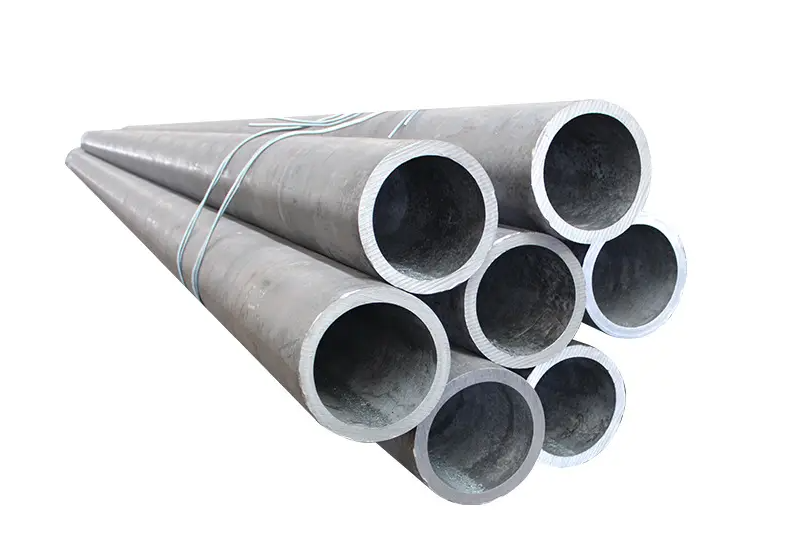ASTM A335 Alloy Steel Pipes

Deep Analysis of ASTM A335 Alloy Steel Pipes
Introduction
ASTM A335 is a specification for seamless ferritic alloy-steel pipes used primarily in high-temperature services. These pipes are crucial in industries that operate under extreme conditions such as power generation, petrochemical processing, and oil and gas extraction. The alloying elements in these pipes provide enhanced mechanical properties, corrosion resistance, and the ability to withstand high temperatures and pressures.
Detailed Composition and Grades
Chemical Composition
The chemical composition of ASTM A335 pipes is tailored to provide specific properties such as high-temperature strength, corrosion resistance, and durability. Here are detailed compositions for some of the most significant grades:
| Specifications | Range |
| Out Diameter | 1/4″- 48″ |
| Wall Thickness | Schedules 40 through 160, STD, XS, XXS. |
Standard: ASME SA 335 American society of mechanical engineers; ASTM A335M American society for Testing and Materials
Uses: For manufacture wall panel, economizer, reheater, superheater and steam pipeline of boilers.
Chemical Composition(%) ASTM A335
ASTM Specification pipe confirming to ASTM A335 shall have the following chemical properties. Tensile and Hardness Requirements The tensile properties of the ASTM A335 pipe shall conform to the requirements as prescribed. Pipe of Grades P91, P92, and P122 shall have a hardness not exceeding 250 HB/265 HV [25 HRC]. For pipe of Grades P91, P92, P122, and P911, Brinell, Vickers, or Rockwell hardness tests shall be made on a specimen from each lot (see Note 7). These pipe bear high resistance to rupture at high temperature and pressures. With hydrogen crack resistance and sulfide stress corrosion cracking chrome moly pipe are highly preferred over Carbon pipe.
| Grade | UN | C≤ | Mn | P≤ | S≤ | Si≤ | Cr | Mo |
|---|---|---|---|---|---|---|---|---|
| P1 | K11522 | 0.10~0.20 | 0.30~0.80 | 0.025 | 0.025 | 0.10~0.50 | – | 0.44~0.65 |
| P2 | K11547 | 0.10~0.20 | 0.30~0.61 | 0.025 | 0.025 | 0.10~0.30 | 0.50~0.81 | 0.44~0.65 |
| P5 | K41545 | 0.15 | 0.30~0.60 | 0.025 | 0.025 | 0.5 | 4.00~6.00 | 0.44~0.65 |
| P5b | K51545 | 0.15 | 0.30~0.60 | 0.025 | 0.025 | 1.00~2.00 | 4.00~6.00 | 0.44~0.65 |
| P5c | K41245 | 0.12 | 0.30~0.60 | 0.025 | 0.025 | 0.5 | 4.00~6.00 | 0.44~0.65 |
| P9 | S50400 | 0.15 | 0.30~0.60 | 0.025 | 0.025 | 0.50~1.00 | 8.00~10.00 | 0.44~0.65 |
| P11 | K11597 | 0.05~0.15 | 0.30~0.61 | 0.025 | 0.025 | 0.50~1.00 | 1.00~1.50 | 0.44~0.65 |
| P12 | K11562 | 0.05~0.15 | 0.30~0.60 | 0.025 | 0.025 | 0.5 | 0.80~1.25 | 0.44~0.65 |
| P15 | K11578 | 0.05~0.15 | 0.30~0.60 | 0.025 | 0.025 | 1.15~1.65 | – | 0.44~0.65 |
| P21 | K31545 | 0.05~0.15 | 0.30~0.60 | 0.025 | 0.025 | 0.5 | 2.65~3.35 | 0.80~1.60 |
| P22 | K21590 | 0.05~0.15 | 0.30~0.60 | 0.025 | 0.025 | 0.5 | 1.90~2.60 | 0.87~1.13 |
| P91 | K91560 | 0.08~0.12 | 0.30~0.60 | 0.02 | 0.01 | 0.20~0.50 | 8.00~9.50 | 0.85~1.05 |
| P92 | K92460 | 0.07~0.13 | 0.30~0.60 | 0.02 | 0.01 | 0.5 | 8.50~9.50 | 0.30~0.60 |
Chrome Moly Pipes: Werkstoff vs EN vs ASTM
ASTM A335 pipe may be either hot finished or cold drawn with the finishing treatment as required in Grade P2 and P12 – The steel shall be made by coarse- grain melting practice. Specific limits, if any, on grain size or deoxidation practice shall be a matter of agreement between the manufacturer and purchaser.
| Werkstoff /DIN | EN | ASTM |
|---|---|---|
| 1.5415 | 16Mo3 | A335 Grade P1 |
| 1.7335 | 13CrMo4-5 | A335 Grade P11, P12 |
| 1.738 | 10CrMo9-10 | A335 Grade P22 |
| 1.7362 | X11CrMo5 | A335 Grade P5 |
| A335 Grade P9 | ||
| 1.4903 | X10CrMoVNb9-1 | A335 Grade P91 |
Tensile Requirements
| Tensile Strength, min., psi | P-5 | P-9 | P-11 | P-22 | P-91 |
|---|---|---|---|---|---|
| ksi | 60 | 60 | 60 | 60 | 85 |
| MPa | 415 | 415 | 415 | 415 | 585 |
| Yield Strength, min., psi | |||||
| ksi | 30 | 30 | 30 | 30 | 60 |
| MPa | 205 | 205 | 205 | 205 | 415 |
Product Analysis At the request of the purchaser, an analysis of two pipe from each lot shall be made by the manufacturer. A lot of ASTM A335 pipe shall consist of the following: NPS Designator Under 2 400 or fraction thereof 2 to 5 200 or fraction thereof 6 and over 100 or fraction thereof.
Note: ASTM A335 P91 shall not have a hardness not exceeding 250 HB/265 HV [25HRC].
Mechanical properties of ASTM A335
| Grade | Tensile strength | Yield strength |
|---|---|---|
| P1,P2 | 380 | 205 |
| P12 | 415 | 220 |
| P23 | 510 | 400 |
| P91 | 585 | 415 |
| P92,P11 | 620 | 440 |
| P122 | 620 | 400 |
Alloying Elements and Their Functions
- Carbon (C): Provides strength and hardness but can reduce ductility.
- Manganese (Mn): Improves toughness and hardenability.
- Phosphorus (P): Enhances strength but can make steel brittle.
- Sulfur (S): Generally considered an impurity, can cause brittleness.
- Silicon (Si): Improves strength and hardness.
- Chromium (Cr): Increases hardness, tensile strength, and corrosion resistance.
- Molybdenum (Mo): Enhances strength, hardenability, and high-temperature stability.
- Vanadium (V): Improves strength and toughness.
- Niobium (Nb): Increases strength and improves weldability.
- Nitrogen (N): Enhances strength and hardness.
Mechanical Properties
The mechanical properties of ASTM A335 pipes are designed to meet the demands of high-temperature and high-pressure applications.
Grade P5
- Tensile Strength: ≥ 415 MPa (60,000 psi)
- Yield Strength: ≥ 205 MPa (30,000 psi)
- Elongation: ≥ 30%
Grade P11
- Tensile Strength: ≥ 415 MPa (60,000 psi)
- Yield Strength: ≥ 205 MPa (30,000 psi)
- Elongation: ≥ 30%
Grade P91
- Tensile Strength: ≥ 585 MPa (85,000 psi)
- Yield Strength: ≥ 415 MPa (60,000 psi)
- Elongation: ≥ 20%
Manufacturing Process
Seamless Pipe Manufacturing
Seamless pipes are produced through several steps:
- Billet Heating: Steel billets are heated to a high temperature to make them malleable.
- Piercing: The heated billet is pierced to create a hollow tube.
- Rolling: The hollow tube is rolled to achieve the desired diameter and wall thickness.
- Sizing: The pipe is further processed to achieve precise dimensions.
Heat Treatment
Heat treatment is critical for achieving the desired mechanical properties and microstructure.
- Normalizing: Heating the pipe to a specific temperature and then cooling it in air to refine the grain structure.
- Tempering: Reheating the pipe to a lower temperature after quenching to improve toughness and reduce brittleness.
- Annealing: Heating the pipe to a high temperature and then slowly cooling it to soften the material and improve ductility.
Testing Requirements
To ensure that ASTM A335 pipes meet the stringent requirements for high-temperature and high-pressure applications, various tests are conducted:
- Tensile Test: Measures tensile strength, yield strength, and elongation.
- Hardness Test: Ensures the material meets specified hardness requirements.
- Hydrostatic Test: Verifies the pipe’s ability to withstand internal pressure without leaking.
- Non-Destructive Testing (NDT): Techniques such as ultrasonic testing (UT) or radiographic testing (RT) are used to detect internal flaws.
- Impact Test: Assesses the material’s toughness, especially for grades requiring high impact resistance.
Applications
ASTM A335 pipes are used in a variety of high-temperature and high-pressure applications, including:
- Power Generation: Boilers, superheaters, and reheaters in power plants.
- Petrochemical Industry: High-temperature processing units and refineries.
- Oil and Gas Industry: Pipelines and processing facilities for high-pressure and high-temperature fluids.
- Industrial Boilers: Piping systems in industrial boilers and heat exchangers.
- Mechanical Engineering: Components subjected to high stresses and temperatures.
Advantages and Limitations
Advantages
- High-Temperature Strength: Able to withstand high temperatures without losing strength.
- Corrosion Resistance: Alloying elements provide excellent resistance to oxidation and corrosion.
- Durability: Designed for long-term performance in harsh environments.
- Versatility: Suitable for a wide range of industrial applications.
Limitations
- Cost: Higher cost compared to carbon steel pipes due to the alloying elements.
- Complex Manufacturing: Requires precise control of chemical composition and heat treatment processes.
- Brittleness: Certain grades can become brittle if not properly heat treated.
Conclusion
ASTM A335 alloy steel pipes are essential for applications requiring high strength, durability, and resistance to high temperatures and pressures. Their superior mechanical properties, combined with rigorous manufacturing and testing processes, ensure they meet the demanding requirements of various industries. Understanding the detailed specifications, grades, and applications of ASTM A335 pipes helps engineers and designers select the right materials for their projects, ensuring safety and efficiency in challenging environments.
By delving into the chemical composition, mechanical properties, manufacturing processes, and applications, this deep analysis provides a comprehensive overview of ASTM A335 alloy steel pipes, highlighting their significance in high-performance industrial applications.







